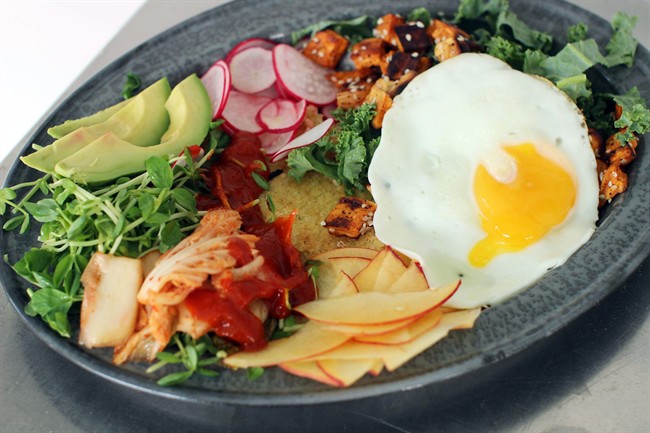Bibimbap is incredibly trendy in urban centres right now. Not familiar with it? You’ll want to be!

Bibimbap is a Korean rice bowl – white rice topped with meats, veggies, kimchee (intensely pickled cabbage) and hot sauce. Often, the meat is tossed in Korean barbecue sauce, lending a perfect sweetness to balance out the tangy and spicy flavours of the other ingredients. Bibimbap is a complete multi-course meal in a bowl, slipping effortlessly into our grab-and-go culinary culture.
And since catching on, the flavour profile has expanded. The classic Korean bibimbap has morphed into the more general “grain bowl” menu, where eaters pick and choose which proteins, veggies and condiments they wish to pile onto a bowl of a cooked grains, anything from brown rice to quinoa.
In my take on bibimbap, I celebrate the traditional combination of sweet-spicy-tangy with sweet potatoes and peaches as the sweet elements, and use a less familiar grain: millet. I keep millet in our house because my daughter is gluten-free, so I like to have a variety of options to cook for the family besides just rice and quinoa.
Like many grains, millet can be paired with either savory or sweet dishes, served instead of rice with a roast or topped with roasted fruit and Greek yogurt for a hearty breakfast. Millet is full of fiber, which helps digestive health, but it also is a good source of B vitamins and minerals, such as iron and magnesium.
I buy millet in the bulk aisle and keep it in a large canning jar in a cool, dark cupboard. Cook it using a 1-to-2 ratio of millet to water, just as you would rice. Simmer for about 20 minutes, then let it rest, covered, for a few minutes for the water to absorb. My bibimbap is great to serve assembled, or feel free to lay out the elements buffet-style and let people build their own.

Get daily National news
—
CRISPY MILLET BIBIMBAP BOWLS
Start to finish: 1 hour
Servings: 4
For the roasted sesame sweet potatoes:
- 2 small sweet potatoes, peeled and cut into small cubes
- 2 teaspoons sesame oil, divided
- 1/4 teaspoon chili powder
- Dash cayenne pepper
- Kosher salt and ground black pepper
- 1 teaspoon sesame seeds
For the bibimbap bowls:
- Peach gochujang sauce (see recipe below)
- 1 tablespoon sesame oil
- 3 1/2 cups warm cooked millet (about 1 cup dry millet)
- 4 small red radishes, thinly sliced
- 1 cup packed chopped kale
- 1 peach, pitted and thinly sliced
- 1 cup pea shoots
- 4 teaspoons lime juice, divided
- 2 teaspoons neutral oil (such as grapeseed or canola)
- 4 eggs, room temperature
- 2 cups vegetable broth, hot
- Kimchee (purchased)
- 1 avocado, pitted, peeled and thinly sliced
Heat the oven to 400 F.
To make the sweet potatoes, on a rimmed baking sheet, toss the sweet potatoes with 1 teaspoon of the sesame oil, the chili powder, cayenne, salt and pepper. Roast for 20 to 25 minutes. Toss with the remaining sesame oil and sesame seeds.
Meanwhile, prepare remaining components. Start by making the peach gochujang sauce (see recipe below). Set aside.
Next, in a medium cast-iron skillet over medium, heat the 1 tablespoon of sesame oil. Add the cooked millet and pat down evenly. Cook for 10 to 15 minutes, or until the millet has formed a crispy layer on the bottom. Remove from the heat.
In separate small bowls, toss the radishes, kale, peach slices and pea shoots each with 1 teaspoon of lime juice. Set aside.
Heat 2 large skillets over low heat. Add 1 teaspoon of neutral oil to each pan and heat for 1 minute. Gently crack 2 eggs into each pan so that they are not touching. Cook for 3 to 5 minutes, or until the whites are set but the yolks are still runny.
To assemble, divide broth among 4 serving bowls, then add a quarter of the millet to each. Top each serving with a quarter of each of the following: kimchee, roasted sesame sweet potatoes, radishes, kale, peach slices, pea shoots, fried eggs and avocado. Serve with peach gochujang sauce on the side.
Nutrition information per serving: 540 calories; 210 calories from fat (39 per cent of total calories); 24 g fat (4 g saturated; 0 g trans fats); 215 mg cholesterol; 860 mg sodium; 68 g carbohydrate; 10 g fiber; 15 g sugar; 16 g protein.
—
PEACH GOCHUJANG SAUCE
Start to finish: 5 minutes
Makes 2 cups
- 1 peach, pitted and quartered
- 1 cup gochujang
- 1 tablespoon rice vinegar
- 2 tablespoons sesame oil
- 3 tablespoons vegetable stock
Place all ingredients in a food processor and puree until smooth.
Nutrition information per 2 tablespoons: 70 calories; 20 calories from fat (29 per cent of total calories); 2.5 g fat (0 g saturated; 0 g trans fats); 0 mg cholesterol; 360 mg sodium; 11 g carbohydrate; 1 g fiber; 6 g sugar; 1 g protein.






Comments